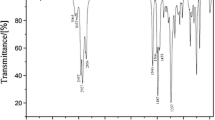Abstract
The gemini surfactant, sodium 4,4′-di(n-tetradecyl) diphenyl methane disulfonate, has been synthesized in four steps with high yield and only one isomer. The structures of intermediate products were analyzed by 1H-NMR spectrometry and elemental analysis. Mass spectrometry was applied to the analysis of the final product. The Krafft point, surface tension, and critical micelle concentration of the aqueous solution and the oil–water interfacial tension were measured. The results indicate that the gemini surfactant exhibits an ultra-low interfacial tension of 7.22 × 10−3 mN/m, which shows potential applications for enhanced oil recovery.







Similar content being viewed by others
References
Zhu YP, Masuyamarn A, Kobata Y (1993) Double-chain surfactants with two carboxylate groups and their relation to similar double-chain compounds. J Colloid Interf Sci 158:40–45
Zhang YM, Zhu H, Xia JH (2007) Synthesis of sulfonate gemini surfactant and its application in tertiary oil recovery. J Beijing Jiaotong Univ 31:101–103
Wang LY, Liu J, Huo SC (2014) Synthesis and surface properties of novel gemini imidazolium surfactants. J Surfactants Deterg 17:1107–1116
Kumar N, Tyagi R (2015) Synthesis and surface studies of anionic gemini surfactant in the different counter-ions. Int J Ind Chem 6:59–66
Zhuang LH, Yu KH, Wang GW (2013) Synthesis and properties of novel ester-containing gemini imidazolium surfactants. J Colloid Interf Sci 408:94–100
Lai L, Mei P, Wu XM (2014) Micellization of anionic gemini surfactants and their interaction with polyacrylamide. Colloid Polym Sci 292:2821–2830
Tiwari AK, Sonu Sowmiya M (2012) Micellization behavior of gemini surfactants with hydroxyl substituted spacers in water and water-organic solvent mixed media: the spacer effect. J Mol Liq 167:18–27
Shah DO (1981) Surface phenomena in enhanced oil recovery. Springer, New York
Xu HJ, Ye ZW, Lv CX (2004) Synthesis and properties of a kind of anionic gemini surfactant. J East China Univ Sci Technol 22:33–37
Ahmadi MA, Zendehboudi S, Shafiei A (2012) Nonionic surfactant for enhanced oil recovery from carbonates: adsorption kinetics and equilibrium. Ind Eng Chem Res 51:9894–9905
Kamal MS, Sultan AD, Al-Mubaiyedh UA (2014) Evaluation of rheological and thermal properties of a new fluorocarbon surfactant-polymer system for EOR applications in high-temperature and high-salinity oil reservoirs. J Surfactants Deterg 17:985–993
Zhou M, Zhao JZ, Wang X (2013) Research on surfactant flooding in high-temperature and high-salinity reservoir for enhanced oil recovery. Tenside Surfactants Deterg 50:175–181
Ahmadi MA, Arabsahebi Y, Shadizadeh SR (2014) Preliminary evaluation of mulberry leaf-derived surfactant on interfacial tension in an oil-aqueous system: EOR application. Fuel 117:749–755
Ma BD, Gao BY, Zhang L (2014) Influence of polymer on dynamic interfacial tensions of EOR surfactant solutions. J Appl Polym Sci 131:40562
Wang HF, Yang Y, Zhang GY (2003) Application prospect of novel gemini surfactants in tertiary oil recovery. Pet Geol Recovery Effic 10:59–61
Zhou YW, Han F, Xu BC (2010) Research progress of anionic gemini surfactant. Chemical World 6:375–379
Benko M, Puskas S, Kiraly Z (2013) Application of mass spectrometry for study of the adsorption of multicomponent surfactant mixtures at the solid/solution interface. Adsorption 19:71–76
Guo YJ, Liu JX, Zhang XM (2012) Solution property investigation of combination flooding systems consisting of gemini-non-ionic mixed surfactant and hydrophobically associating polyacrylamide for enhanced oil recovery. Energ Fuel 26:2116–2123
Gao B, Sharma MM (2013) A family of alkyl sulfate gemini surfactants. 2. Water–oil interfacial tension reduction. J Colloid Interf Sci 407:375–381
Zhang R, Zhou JW, Peng L (2013) The wettability alteration behavior of cationic gemini surfactants on oil-aged mica mineral surfaces. Tenside Surfactants Deterg 50:214–218
Wei H, Wei L, Yin JH (2010) Fractal applications in fluid mechanics of enhancing oil recovery from low-permeability oil reservoirs by gemini surfactant flooding. Appl Mech Mater 29–32:163–169
Alul HR, Clark SG and Mcewan GJ (1967) Alkyl aryl process. US Patent 3,349,144
Alul HR (1968) Control of isomer distribution of straight-chain alkylbenzenes. Ind Eng Chem Prod Res Dev 7:7–11
Zhang X, Ma GW, Chen T (2007) Preparation of 2,7-dibromo fluorene by reduction of 2,7-dibromo fluorenone with zinc amalgam and hydrochloric acid. Fine Chem 10:932–935
Yu T, Hu LJ, Ding W (2004) A new surfactant-synthesis and properties of dialkyl disulfonate diphenyl dethane. J Daqing Pet Inst 28:35–38
Zana R (2002) Alkanediyl-α, ω-bis(dimethylalkylammonium bromide) surfactants: II. Krafft temperature and melting temperature. J Colloid Interface Sci 252:259–261
Rosen MJ (1993) Gemini: a new generation of surfactants. Chemtech 23:30–34
Vonnegut B (1942) Rotating bubble method for the determination of surface and interfacial tensions. Rev Sci Instrum 13:6–9
Huang H, Mao SC (2007) Fine chemicals commonly used instrument analysis. South China Univ Technol Press, Guangzhou
Szyszkowski BV (1908) Surface tension of the aqueous surfactant solution. Z Phys Chem 64:385
Evans HC (1956) Critical micelle concentrations of the sodium salts. J Chem Soc 80:579–586
Aguiar HB, Strader ML, Beer AGF (2011) Surface structure of sodium dodecyl sulfate surfactant and oil at the oil-in-water droplet liquid/liquid interface: a manifestation of a nonequilibrium surface state. J Phys Chem B 115:2970–2978
Yuan QS (2003) Study of dynamic interfacial tension characteristic and its influencing factors. Pet Geol Recovery Effic 10:60–61
Liu S, Zhang DL, Yan W (2008) Favorable attributes of alkaline surfactant polymer flooding. SPE J 13:2–6
Hirasaki G, Miller CA, Puerto M (2008) Recent advances in surfactant EOR. SPE J 16:889–907
Acknowledgments
We are grateful for the financial support from the Fundamental Research Funds for the Central Universities (JUSRP51513).
Author information
Authors and Affiliations
Corresponding author
About this article
Cite this article
Xu, K., Wang, D. & Xu, H. Synthesis and Properties of 4,4′-Di(n-Tetradecyl) Diphenyl Methane Disulfonate Salt. J Surfact Deterg 19, 693–699 (2016). https://doi.org/10.1007/s11743-016-1840-9
Received:
Accepted:
Published:
Issue Date:
DOI: https://doi.org/10.1007/s11743-016-1840-9




